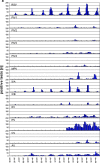Ten years' experience with year-round active surveillance of up to 19 respiratory pathogens in children
- PMID: 17569085
- PMCID: PMC7087302
- DOI: 10.1007/s00431-007-0496-x
Ten years' experience with year-round active surveillance of up to 19 respiratory pathogens in children
Abstract
Introduction: Surveillance systems for acute respiratory infections (ARI) in children currently are often limited in terms of the panel of pathogens and the age range investigated or are only syndromic and at times only active in the winter season.
Methods: Within PID-ARI.net, a research network for ARI in children in Germany, an active, year-round surveillance system was formed in three regions from north to south for population-based analysis. Children from birth to 16 years of age were included and up to 19 noncolonizing airway pathogens were tested for with multiplex RT-PCR.
Results: In the 10-year period from July 1996 to June 2006, a total of 18,899 samples were tested. The positive rate increased with the size of the test panel to up to 72.9%. Picornaviruses (35-39%), paramyxoviruses (23-28%) and orthomyxoviruses (5.8-12.5%) comprised the highest fraction. Reoviruses and Legionella pneumophila were not found at all and Chlamydia pneumoniae and Bordetella parapertussis only rarely. Respiratory syncytial virus and parainfluenza virus (PIV) type 3 were anticyclical in rhythmicity with metapneumovirus and PIV1 and PIV2. The age medians per pathogen depended predominantly upon the attack rate and interepidemic intervals.
Conclusion: Active surveillance systems for ARI are superior to passive systems. They should be pathogen-specific and comprehensive for viruses and bacteria and age ranges. They should be population-based and multilevel to avoid bias. The impact of atypical bacteria in children was highly overestimated in earlier studies.
Figures




Similar articles
-
[Etiology of acute respiratory tract infection in hospitalized children in Suzhou from 2005 to 2011].Zhonghua Yu Fang Yi Xue Za Zhi. 2013 Jun;47(6):497-503. Zhonghua Yu Fang Yi Xue Za Zhi. 2013. PMID: 24113096 Chinese.
-
PID-ARI.net - a pediatric infectious diseases network on acute respiratory infections and the added value of a multilevel research network.Klin Padiatr. 2008 Sep-Oct;220(5):281-6. doi: 10.1055/s-2007-985815. Epub 2008 Feb 6. Klin Padiatr. 2008. PMID: 18256975 Review.
-
[Prevalence and seasonal distribution of respiratory viruses in patients with acute respiratory tract infections, 2002-2014].Mikrobiyol Bul. 2015 Apr;49(2):188-200. doi: 10.5578/mb.9024. Mikrobiyol Bul. 2015. PMID: 26167819 Turkish.
-
Single- and multiple viral respiratory infections in children: disease and management cannot be related to a specific pathogen.BMC Infect Dis. 2017 Jan 11;17(1):62. doi: 10.1186/s12879-016-2118-6. BMC Infect Dis. 2017. PMID: 28077074 Free PMC article.
-
Etiology of Acute Respiratory Infections in Infants: A Prospective Birth Cohort Study.Pediatr Infect Dis J. 2017 Jan;36(1):25-30. doi: 10.1097/INF.0000000000001359. Pediatr Infect Dis J. 2017. PMID: 27753796
Cited by
-
Rhinovirus infections in western Sweden: a four-year molecular epidemiology study comparing local and globally appearing types.Eur J Clin Microbiol Infect Dis. 2013 Jul;32(7):947-54. doi: 10.1007/s10096-013-1832-x. Epub 2013 Feb 23. Eur J Clin Microbiol Infect Dis. 2013. PMID: 23435753 Free PMC article.
-
Viral respiratory infections in hospitalized and community control children in Alaska.J Med Virol. 2010 Jul;82(7):1282-90. doi: 10.1002/jmv.21790. J Med Virol. 2010. PMID: 20513097 Free PMC article.
-
Nasal swab bacteriology by PCR during the first 24-months of life: A prospective birth cohort study.Pediatr Pulmonol. 2019 Mar;54(3):289-296. doi: 10.1002/ppul.24231. Epub 2019 Jan 4. Pediatr Pulmonol. 2019. PMID: 30609299 Free PMC article.
-
Respiratory viral infections in infants: causes, clinical symptoms, virology, and immunology.Clin Microbiol Rev. 2010 Jan;23(1):74-98. doi: 10.1128/CMR.00032-09. Clin Microbiol Rev. 2010. PMID: 20065326 Free PMC article. Review.
-
Mycoplasma pneumoniae pneumonia revisited within the German Competence Network for Community-acquired pneumonia (CAPNETZ).BMC Infect Dis. 2009 May 13;9:62. doi: 10.1186/1471-2334-9-62. BMC Infect Dis. 2009. PMID: 19439072 Free PMC article.
References
-
- Florman AL, McLean LC. The effect of altitude and weather on the occurrence of outbreaks of respiratory syncytial virus infections. J Infect Dis. 1988;158:1401–1402. - PubMed
-
- Graham NMH. Respiratory infections. In: Pless IB, editor. The epidemiology of childhood disorders. New York: Oxford University Press; 1994. pp. 173–210.
Publication types
MeSH terms
LinkOut - more resources
Full Text Sources
Medical

